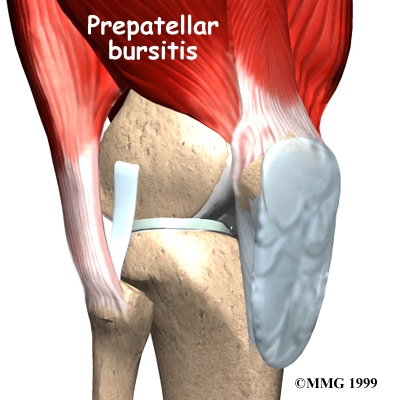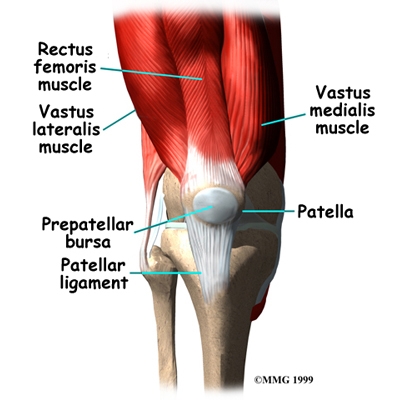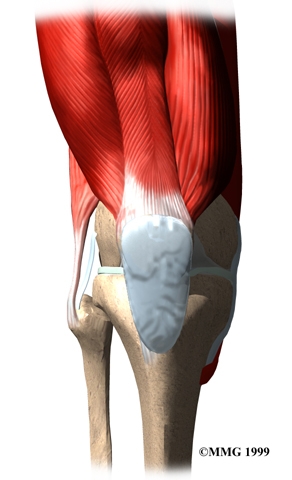A Patient's Guide to Prepatellar Bursitis

Introduction
Prepatellar bursitis is the inflammation of a small sac of fluid located in front of the kneecap. This inflammation can cause many problems in the knee.
This guide will help you understand
- how prepatellar bursitis develops
- why the condition causes problems
- what can be done for your pain
Chiropractic Treatment
Chronic prepatellar bursitis is can be a real nuisance. Chronic prepatellar bursitis will usually improve over a period of time from weeks to months with proper treatment. The fluid-filled sack is not necessarily a problem, and if it does not cause pain, it is not always a cause for alarm or treatment. The sack of fluid may come and go with variation in activity. This is normal.
The swelling and tenderness often gets in the way of kneeling and causes pain. For people who do things requiring kneeling, this creates a hardship both in their occupation and recreational activities. Treatment usually starts by trying to control the inflammation and determining what has caused the problem in the first place. This may include a short period of rest or possibly a brace to immobilize the knee. A knee pad may be useful in making it easier to kneel on the affected knee. People with jobs that require them to be on their knees frequently should probably consider knee pads before the problem starts.
Chiropractors will often use heat, ice, and ultrasound to help calm the pain and swelling. We may also instruct you in specialized stretching and strengthening exercises used in combination with a knee brace, taping of the patella, or shoe inserts. These exercises and aids are used to improve muscle balance and joint alignment of the hip and lower limb, easing pressure and problems in the bursa. The feet should always be checked for poor or faulty biomechanics. The feet are the foundation of the body and many foot conditions eventually contribute to knee, hip and lower back problems. Orthotics for your shoes and sneakers will have a significant effect in reducing excessive biomechanical forces on the knee. At the Winchester Hospital Chiropractic Center, we can take molds of your feet and fit you for custom made orthotics.
It is imperative that we make sure that there is no infection. If an infection is found to be causing the prepatellar bursitis, the bursa will need to be drained with a needle--perhaps several times over the first few days. If this is the case, we will refer you to an orthopedist for drainage and possible antibiotics. The body will absorb the some of the blood in the bursa over several weeks, and the bursa should return to normal.
Anatomy
Where is the prepatellar bursa, and what does it do?
A bursa is a sack made of thin, slippery tissue. Bursae occur in the body wherever skin, muscles, or tendons need to slide over bone. Bursae are lubricated with a small amount of fluid inside that helps reduce friction from the sliding parts.
The prepatellar bursa is located between the front of the kneecap (called the patella) and the overlying skin. This bursa allows the kneecap to slide freely underneath the skin as we bend and straighten the knee.

Causes
How does prepatellar bursitis develop?
Bursitis is the inflammation of a bursa. The prepatellar bursa can become irritated and inflamed in a number of ways.
In some cases, a direct blow or a fall onto the knee can damage the bursa. This usually causes bleeding into the bursa sack, because the blood vessels in the tissues that make up the bursa are damaged and torn. In the skin, this would simply form a bruise, but in a bursa blood may actually fill the bursa sack. This causes the bursa to swell up like a rubber balloon filled with water.
The blood in the bursa is thought to cause an inflammatory reaction. The walls of the bursa may thicken and remain thickened and tender even after the blood has been absorbed by the body. This thickening and swelling of the bursa is referred to as prepatellar bursitis.
Prepatellar bursitis can also occur over a longer period of time. People who work on their knees, such as carpet layers and plumbers, can repeatedly injure the bursa. This repeated injury can lead to irritation and thickening of the bursa over time. The chronic irritation leads to the same condition in the end--prepatellar bursitis.
The prepatellar bursa can also become infected. This may occur without any warning, or it may be caused by a small injury and infection of the skin over the bursa that spreads down into the bursa. In this case, instead of blood or inflammatory fluid in the bursa, pus fills it. The area around the bursa becomes hot, red, and very tender.
Symptoms
What does prepatellar bursitis feel like?
Prepatellar bursitis causes pain and swelling in the area in front of the kneecap and just below. It may be very difficult to kneel down and put the knee on the floor due to the tenderness and swelling. If the condition has been present for some time, small lumps may be felt underneath the skin over the kneecap. Sometimes these lumps feel as though something is floating around in front of the kneecap, and they can be very tender. These lumps are usually the thickened folds of bursa tissue that have formed in response to chronic inflammation.
The bursa sack may swell and fill with fluid at times. This is usually related to your activity level, and more activity usually causes more swelling. In people who rest on their knees a lot, such as carpet layers, the bursa can grow very thick, almost like a kneepad in front of the knee.

Finally, if the bursa becomes infected, the front of the knee becomes swollen and very tender and warm to the touch around the bursa. You may run a fever and feel chills. An abscess, or area of pus, may form on the front of the knee. If the infection is not treated quickly, the abscess may even begin to drain, meaning the pus begins to seep out.
Diagnosis
How do doctors identify the condition?
The diagnosis of prepatellar bursitis is usually obvious from the physical examination. In cases where the knee swells immediately after a fall or other injury to the kneecap, X-rays may be necessary to make sure that the kneecap isn't fractured. Chronic bursitis is usually also easy to diagnose without any special tests.
If your doctor is uncertain whether or not the bursa is infected, a needle may be inserted into the bursa and the fluid removed. This fluid will be sent to a lab for tests to determine whether infection is present, and if so, what type of bacteria is causing the infection and what antibiotic will work best to cure the infection.
All content provided by eORTHOPOD® is a registered trademark of Medical Multimedia Group, L.L.C.. Content is the sole property of Medical Multimedia Group, L.L.C.. and used herein by permission.
All materials from eORTHOPOD® are the sole property of Medical Multimedia Group, L.L.C.. and are used herein by permission. eORTHOPOD® is a registered trademark of Medical Multimedia Group, L.L.C..
|